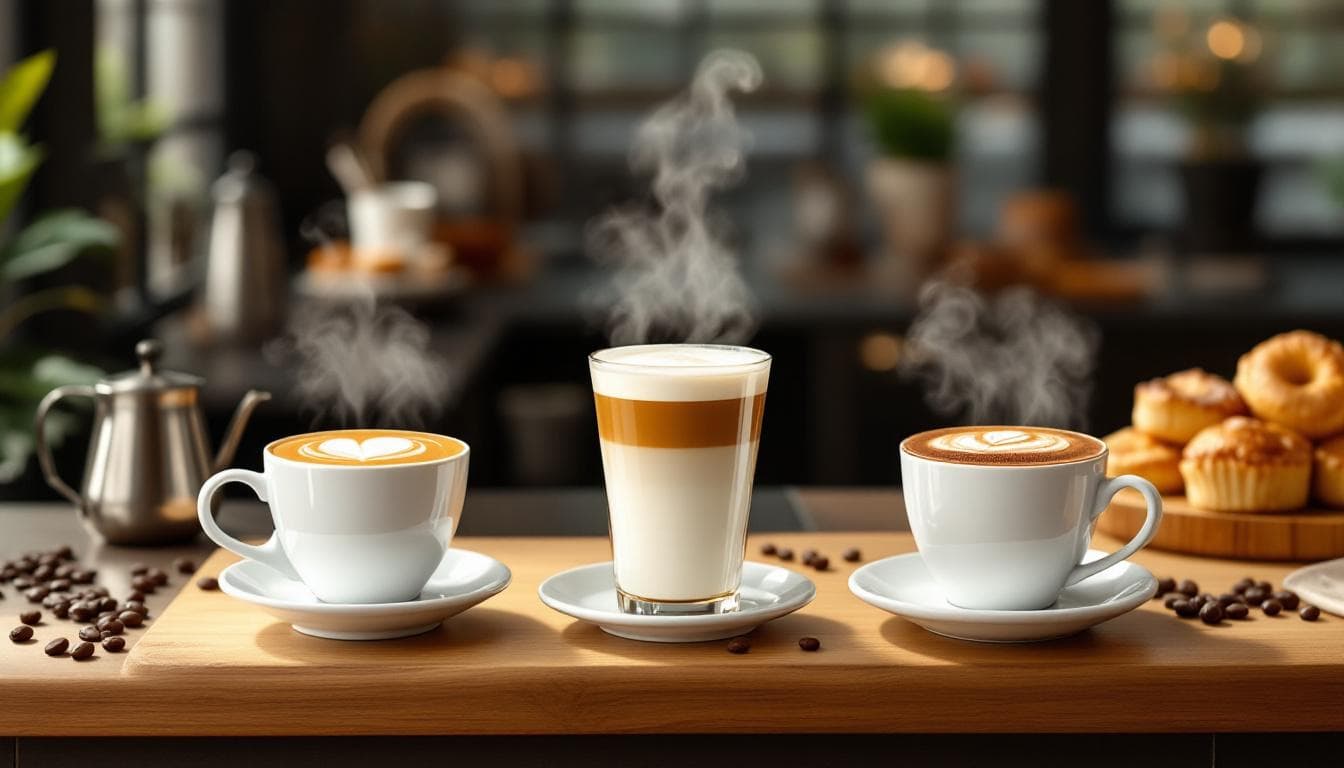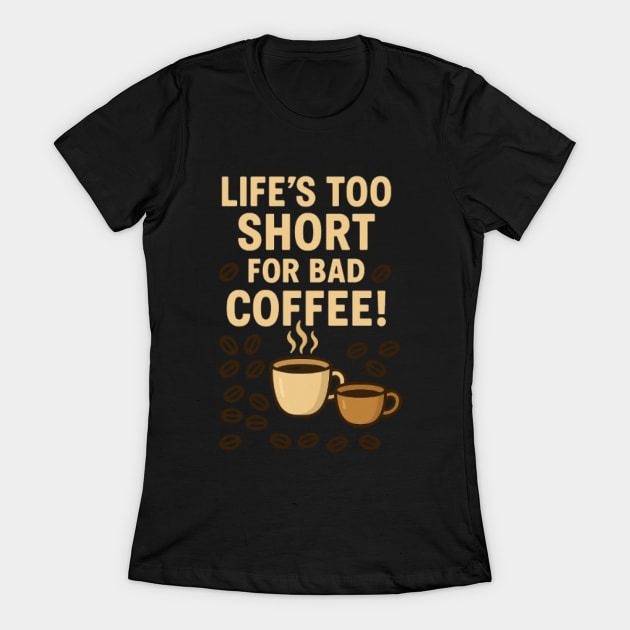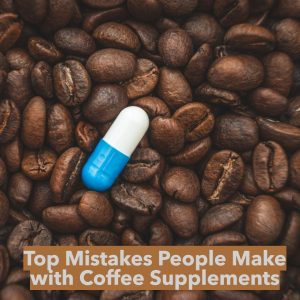Choosing the Best Coffee for Your Taste and Health
Flat white vs latte vs cappuccino: which espresso-based drinks best match your taste preferences, health needs, and daily routine?
All three start with a rich espresso shot, but the key difference lies in the coffee-to-milk ratio and milk texture.
Flat whites offer a velvety texture and creamy texture with a strong espresso flavor, while lattes present a smooth, milky coffee experience with more steamed milk and a milder taste.
Cappuccinos stand out with their distinct milk foam, balancing equal parts of foam, milk, and espresso for an airy, robust cup.
This straightforward guide helps you understand the differences in cup size, milk foam, and espresso flavor, making it easier to select the perfect coffee drink for your morning boost or afternoon pick-me-up.
Whether you’re after the bold punch of espresso, curious about how milk texture influences coffee flavor, or want to know which is best for your home coffee maker, we’ve got you covered.
For those who enjoy experimenting, we’ll also explore cold brew, selecting the right coffee beans, opting for decaf coffee, and incorporating safe supplements to support your health.
Let’s break down your favorite coffee shop menu and show you how to brew your best cup of coffee at home.

Key Takeaways:
- These espresso-based drinks differ primarily in their coffee-to-milk ratio and milk texture.
- Flat white: velvety texture with a creamy texture that highlights strong coffee and espresso flavor.
- Latte: more steamed milk creates a milky coffee style with a mellow taste and subtle foam.
- Cappuccino: features equal parts espresso, milk, and milk foam for a perfectly balanced cup.
- Making these coffee drinks at home is easy with quality coffee beans and the right coffee maker.
- You can switch to decaf coffee or add supplements to align with your health goals.
- Learn tips on choosing the best coffee beans and brewing safely for a better coffee flavor every day.
Watch this video on cappuccino vs latte vs flat white and more!
Understanding the Basics of Each Drink
Choosing between a flat white, latte, and cappuccino ultimately comes down to understanding the ingredients inside each cup of these popular espresso-based drinks.
Every recipe starts with a shot of espresso, but it’s the coffee to milk ratio and milk texture—especially the foam and microfoam—that create the distinct experience of each drink.
If you’ve ever wondered why a cappuccino features thick, dense milk foam or why a flat white offers such a strong coffee flavor, exploring each drink’s composition will clarify how these elements influence their unique profiles.
These classic coffee shop beverages differ primarily in their espresso to milk ratio and signature milk foam styles, making every sip memorable.
Flat White: Origin and Composition
The flat white has gained fame for its creamy texture combined with a strong coffee presence.
Originating from Australia or New Zealand (the debate goes on!), it’s designed to emphasize the pure espresso flavor with a velvety texture.
Typically served in a smaller cup size of 5–6 oz, the flat white delivers a bolder, more concentrated strong coffee experience thanks to its higher coffee to milk ratio compared to similar drinks.
Baristas prepare a flat white using a double shot of espresso layered with approximately twice the amount of silky microfoam—steamed milk that feels smooth and dense, free of large bubbles, giving it that signature velvety texture.
This microfoam is carefully folded into the espresso rather than sitting as foam on top, creating a unified drink where the espresso flavor truly shines.
High-quality coffee beans and precise espresso pulling are essential to balancing the creamy texture without overpowering milk foam.
Key features of the flat white:
- Double espresso base delivering a robust espresso flavor.
- Higher coffee-to-milk ratio for a strong coffee profile.
- Served in a 5–6 oz cup size, perfect for a focused experience.
- Microfoam with a velvety texture, seamlessly blended into the espresso.
- Ideal for those who enjoy a smooth texture with bold espresso flavor.
For a detailed breakdown of how these drinks differ, this comparison from Breville is a great resource.

Latte: Milk-Heavy Comfort
The latte is the quintessential comfort drink for those who prefer a milky coffee experience with plenty of steamed milk.
Made with one or two shots of espresso, the latte features the largest serving size—often 8 to 12 oz.
It’s known for generous amounts of steamed milk topped by a thin layer of milk foam, about a centimeter thick, resting gently as foam on top rather than dense microfoam.
Because of its high volume of milk, the latte delivers a creamy texture that’s smooth and mellow, making it approachable even for newcomers to espresso.
It’s also the go-to drink for latte art, with baristas commonly creating patterns like hearts and leaves on the milk foam.
Coffee lovers often enhance lattes with flavored syrups such as vanilla or caramel, where the high milk content complements sweetness beautifully.
All you need to craft a proper latte at home is an espresso machine or a coffee maker with a steam wand.
For tips on bringing coffee shop techniques into your kitchen, check out the Brown Sugar Shaken Espresso Recipe for inspiration on milk-forward espresso based drinks.
Why people love lattes:
- Largest serving size with a smooth, creamy texture.
- Light, thin milk foam perfect for latte art.
- Ideal for experimenting with flavors and syrups.
- Mild and milky coffee, great for easing into espresso drinks.
If you’re curious about making espresso-based drinks without expensive equipment, this homemade espresso guide covers methods suitable for lattes and other favorites.
Cappuccino: Balanced Foam
Famous for its airy milk foam and harmonious flavor, the cappuccino offers a well-balanced experience with equal parts espresso, steamed milk, and thick microfoam—usually served in a 6 oz cup.
This classic coffee to milk ratio creates a rich espresso flavor complemented by creamy milk and a dense milk foam layer that is spoonable and can hold toppings like a dusting of cocoa or cinnamon.
The cappuccino’s defining element is its thick milk foam, which locks in flavor and heat, allowing each sip to be thoroughly enjoyed.
This milk texture balance ensures the coffee beans’ rich essence is perfectly complemented by the milky coffee and luxurious milk foam.
Some prefer it sweetened, but many appreciate cappuccinos plain to fully enjoy the textures.
For a comprehensive look at cappuccino milk foam and its impact on taste, the article What is cappuccino? offers history and barista insights.
To see the differences clearly, this flat white vs latte vs cappuccino guide is a useful reference.
What sets cappuccinos apart:
- Classic 1:1:1 ratio of espresso, steamed milk, and thick milk foam.
- Small cup size maintains a robust and satisfying drink.
- Dense milk foam enhances both flavor and heat retention.
- Versatile—enjoy plain or with sweet toppings.
- Perfect for those who appreciate rich foam balanced with bold espresso.
Here’s a quick recap table illustrating these defining traits:
Here’s a quick, friendly guide to three classic espresso drinks:
- Flat White: double shot of espresso, steamed milk with a thin texture, silky microfoam, typical size 5 to 6 oz.
- Latte: single or double espresso, lots of steamed milk, light and thin foam on top, typical size 8 to 12 oz.
- Cappuccino: single or double espresso, equal parts steamed milk and foam, thick and dense milk foam, typical size 6 oz.
Each choice has its fans, but now you understand the composition that suits your taste—whether you prioritize espresso flavor intensity, creamy texture, or frothy balance.
Alongside exploring cold brew or decaf options, the world of espresso based coffee drinks offers something for every coffee moment.
For more expert tips on home brewing and espresso preparation, see best ways to brew coffee at home and elevate your coffee routine.

Taste, Texture, and Health Impact
When deciding between a flat white, latte, and cappuccino, many wonder how each coffee drink differs in espresso flavor, milk texture, and their impact on health.
To help you find the ideal option for your daily routine, let’s break down what makes each espresso-based drink unique in terms of coffee flavor, milk consistency, and wellness considerations.
Flavor Profile Comparison
Coffee lovers can easily notice subtle differences with every sip. Here’s an in-depth look:
- Flat White: Perfect for those who enjoy strong coffee and want the espresso flavor to stand out. With a higher espresso-to-milk ratio, the flat white delivers a velvety texture and a creamy texture that enhances the rich, bold coffee flavor.
- The silky microfoam blends seamlessly, creating a smooth yet intense experience.
- If you prefer a beverage that highlights the pure essence of espresso with just a touch of milk, the flat white is often regarded as the strongest-tasting option among milky coffee choices.
- Latte: Known for its creamy, comforting qualities, the latte features more steamed milk and a larger cup size than the flat white.
- This creates a mild, velvety coffee flavor that suits anyone who loves a softer, milky coffee experience.
- The latte also pairs well with flavored syrups, making it a versatile choice for those seeking a gentle start with a subtle sweetness.
- Cappuccino: Balancing equal parts espresso, steamed milk, and milk foam, the cappuccino offers a unique milk texture and foam on top. This foam traps heat and aroma, enriching each sip with fluffy lightness that contrasts the bold coffee taste beneath.
- The smaller serving size and distinct milk foam make the cappuccino a strong yet softened option for a well-rounded coffee experience.
For more on the milk texture and foam differences in these popular drinks, check out this helpful guide.
Key Takeaways:
- Flat white: Strong coffee with a velvety texture and espresso-forward flavor.
- Latte: Creamy and mild, perfect for a smooth milky coffee.
- Cappuccino: Bold coffee with distinctive milk texture and foam on top.
Calorie and Fat Content
Curious about how many calories come with your favorite cup? The calorie count mainly depends on cup size and milk choice.
Here’s a typical overview for a 6-ounce serving size using whole milk:
| Drink | Calories (approx.) | Fat (g) | Notes |
|---|---|---|---|
| Flat White | 80 to 100 | 4 to 5 | Smaller cup, higher espresso to milk ratio |
| Latte | 120 to 180 | 6 to 9 | Larger serving, more steamed milk |
| Cappuccino | 80 to 100 | 4 to 5 | Smaller serving, milk foam adds light volume |
- Both the flat white and cappuccino have smaller cup sizes, which help keep calorie and fat content lower.
- The latte’s bigger serving size and increased milk content lead to more calories.
- To reduce calories, try swapping whole milk for plant-based options like almond or oat milk. Note that almond milk generally lowers the calorie count, while oat milk can add a bit more.
- Because foam on cappuccinos contains lighter milk, the calorie increase isn’t as significant as one might expect.
When tracking macros carefully, remember that choosing the best drink is about more than just flavor—it’s also about fitting your lifestyle.
Opting for smaller serving sizes or lighter milk alternatives can have a noticeable impact.

Caffeine and Decaf Choices
All three of these espresso-based drinks start with espresso shots.
Here is what you should know about caffeine content and decaf coffee options for a gentler boost.
- A single shot of espresso (about 1 ounce) contains roughly 60–80 mg of caffeine.
- Flat whites typically come with a double shot, providing 120–160 mg caffeine.
- Lattes and cappuccinos usually include a single shot, though you can request a double shot for extra strength.
Adding steamed milk or milk foam doesn’t lessen caffeine; it dilutes the concentration, resulting in a smoother taste while maintaining the caffeine kick per shot.
- Looking to cut back on caffeine? Decaf coffee is easily substituted in any of these drinks.
- Decaf espresso contains only a few milligrams of caffeine per shot—enough to enjoy the coffee flavor without the buzz.
- Brewing at home? Using an espresso machine allows you to choose between regular and decaf coffee beans, giving you full control over strength and caffeine levels.
For more about decaf coffee’s health effects and tips on choosing the best coffee beans or brewing methods, see this advice on making espresso at home without a machine.
Key Takeaways:
- Espresso caffeine content ranges from 60–80 mg per shot (double shots for flat white).
- Decaf coffee is a great option for a lower-caffeine, flavorful experience.
- You can adjust shot count and choose coffee beans to customize your drink’s strength.
For a deep dive into how coffee drinks, brewing styles, and coffee bean selections affect health and energy, visit this detailed analysis on Coffee Blog.
Summary of This Section:
- Choosing between flat white, latte, and cappuccino comes down to whether you want strong coffee with a velvety texture, mild and creamy milky coffee, or bold coffee with unique milk texture and foam.
- Calorie and fat levels depend heavily on cup size and milk type; opting for smaller servings or plant-based milks helps keep calories in check.
- The espresso base gives each drink its signature kick, while decaf coffee offers flavorful, low-caffeine alternatives.
Keep these insights in mind next time you order from the coffee bar or prepare your favorite espresso based drinks on your espresso machine at home!
Choosing the Right Drink for Your Lifestyle
Coffee is more than just a ritual; it reflects your lifestyle, pace, and even your plans for the afternoon.
Deciding between a flat white, latte, or cappuccino comes down to finding the coffee drink that suits your mood and daily rhythm.
Let’s explore how each of these espresso-based drinks fits into your routine, what equipment you need to craft them at home, and why cold brew versions are worth trying when the temperature rises.
Morning Boost vs Afternoon Sip
Different times of day call for distinct energy levels, and this is where the traditional flat white, latte, and cappuccino shine:
- Flat White: The traditional flat white is the barista’s pick for a focused morning boost. It offers a strong coffee experience with a bold espresso shot combined with a velvety texture thanks to its delicate microfoam.
- This drink’s rich espresso flavor makes it ideal for early risers craving strong coffee to jumpstart their day.
- Latte: When the day calls for a gentler touch, the latte steps in with its creamy texture and larger cup size.
- This milky coffee has a smooth milk texture that pairs well with flavor additions like vanilla or caramel.
- It’s perfect for relaxed midday breaks, studying, or coffee dates. Plus, those who prefer decaf coffee can enjoy the latte’s milky coffee comfort without the caffeine jitters, and can even practice latte art at home with the right milk and foam technique.
- Cappuccino: As the afternoon slump sets in, a cappuccino provides a balanced lift. Combining espresso with steamed milk and a generous foam on top, it offers a light yet energizing drink.
- The thicker milk foam helps retain warmth and enhances the creamy texture, making it a favorite for those seeking a satisfying but not heavy coffee drink.
Here’s a quick overview of which drink fits your moment:
- Flat White
Best for: focused mornings
Why it works: bold espresso flavor with a silky texture, balanced ratio of espresso to milk. - Latte
Best for: relaxed midday breaks
Why it works: plenty of milk in the largest cup, smooth and easy to sip, great with decaf too. - Cappuccino
Best for: an afternoon boost
Why it works: balanced mix of espresso and steamed milk, topped with airy foam for a creamy finish.
Which one fits your day today?
Curious about the nuances between these coffee drinks? Check out this quick difference guide for more details.
Equipment Needs
You don’t need a full coffee shop setup to enjoy high-quality coffee drinks at home.
With a few essential tools and fresh coffee beans, you can make flat whites, lattes, and cappuccinos like a pro:
- Espresso machine or coffee maker with a frother: The espresso machine is key for authentic espresso flavor and pressure in your drinks.
- Beginner-friendly coffee makers often include built-in frothers ideal for steaming milk the right way.
- Milk pitcher: This metal jug is essential for steaming and pouring milk smoothly, especially if you want to try your hand at latte art that showcases precise milk texture.
- Milk frother: Whether manual or electric, a frother lets you create the perfect microfoam for a traditional flat white or the denser milk foam needed for a cappuccino.
- Quality coffee beans: The freshest coffee beans will elevate the flavor profile of your drink. Look for small-batch or specialty beans to maximize aroma and taste.
If you don’t own an espresso machine, a simple milk frother can still help you get close to café-quality lattes and flat whites, though cappuccinos require thicker foam and more precise frothing time.
For more on picking the right gear and mastering brew methods, this guide on how to make espresso at home without a machine is an excellent resource.

When to Try Cold Brew Versions
As the weather warms, cold brew offers a refreshing alternative without sacrificing coffee flavor or creamy texture.
Cold brew pairs beautifully with milk, allowing you to enjoy chilled versions of flat white, latte, or cappuccino with simple adjustments:
- Cold flat white: Combine cold brew concentrate with cold milk and a splash of smooth microfoam for a strong, cool pick-me-up that maintains the traditional flat white’s rich espresso flavor.
- Iced latte: Pour cold brew and plenty of milk over ice to make a creamy, milky coffee that refreshes and energizes simultaneously.
- Iced cappuccino: Top cold brew with fluffy milk foam to create that signature light texture, now served chilled.
These cold brew variations retain the taste and texture differences of their hot counterparts without the heat.
Using cold milk and cold foam with cold brew ensures your cup stays creamy and satisfying.
Cold brew is also gentler on the stomach due to its lower acidity and works well with decaf coffee for an evening treat that won’t interfere with sleep.
For recipes and brewing tips, check out this article on the best ways to brew coffee at home.
For a deeper, science-backed explanation of popular coffee drink types, visit this detailed overview of coffee drink differences, helping you select your next favorite.
Key Takeaways:
- Flat white offers bold, velvety texture and strong coffee to kickstart your morning.
- Latte delivers a mild, milky coffee experience ideal for relaxation or enjoying decaf coffee.
- Cappuccino balances steamed milk and foam on top for a light, afternoon energy boost.
- These coffee drinks come in hot or iced versions to suit your mood and weather.
- Using the right espresso machine, quality coffee beans, and tools lets you craft coffee shop-style drinks at home.
- Cold brew options provide a smooth, less acidic taste without losing creamy texture or coffee flavor.
Ready to brew your next cup?
The best coffee drinks are those that perfectly match your day, your equipment, and your taste preferences.
Coffee Supplements and Wellness
Coffee is more than just a flavorful drink; it can also play a key role in your daily well-being.
While many people enjoy popular espresso-based drinks like flat white, latte, and cappuccino, they might not realize how the ingredients in your cup—ranging from freshly ground coffee beans to steamed milk and milk foam—can influence your energy, mood, and overall health.
Today, more individuals are turning to supplements that complement their favorite brew, transforming coffee into a valuable part of a balanced, healthy routine.
Let’s explore how coffee supports wellness, the benefits Java Burn offers, and tips for enjoying these advantages safely every day.
How Coffee Supports Health
Coffee does much more than help you wake up.
Research shows that coffee supplies natural antioxidants found in coffee beans, which act as tiny protectors shielding your cells from everyday stress and damage.
These antioxidants in coffee drinks serve as little shields—studies even suggest they may help defend your body from cell damage over the long term.
Beyond antioxidants, coffee positively impacts metabolism, the process that converts food into energy.
Enjoying a cup of espresso or cold brew can give this metabolic process a gentle boost, often leaving you feeling more alert and even experiencing a warming sensation.
Don’t underestimate coffee’s effect on mood either.
Many savor their break with a beverage crafted by a skilled barista, making moments with a flat white or cappuccino particularly enjoyable.
Natural compounds in coffee beans can enhance “feel-good” chemicals in the brain, helping elevate your mood during social times or quiet mornings.
- Key highlights:
- Coffee provides natural antioxidants.
- It supports metabolism to boost energy.
- Sharing coffee drinks with friends can improve mood.
To maximize your coffee’s potential, explore expert tips for the best ways to brew coffee at home.
Choosing the right espresso machine and methods to preserve coffee flavor will enhance every cup, whether you prefer espresso, latte, or a milk foam-topped cappuccino.
Introducing Java Burn
Java Burn is a natural supplement specifically designed to blend effortlessly with your morning brew—be it a flat white, cappuccino, or even decaf coffee.
This unique formula works in harmony with espresso-based drinks to enhance energy and metabolism, making it an ideal addition for those aiming to start the day healthier and simpler.
What makes Java Burn stand out:
- It complements your favorite coffee drinks, not replaces them.
- Compatible with various brews, including cold brew and espresso with steamed milk.
- Easily fits into a healthy lifestyle without substituting meals or balanced nutrition.
Many users report feeling more energized and focused from morning workouts straight through busy afternoons.
Want to learn more about real experiences? Check out genuine reviews and detailed information on how Java Burn supports metabolism here: Java Burn Complaints Investigated: 2025 User Reviews.
Remember, results vary with each individual.
Curious about how Java Burn mixes with your favorites?
It blends smoothly into almost any coffee drink—from espresso shots topped with silky steamed milk and milk foam to creamy lattes—just be sure to follow the recommended serving size and maintain a balanced diet.
Tips for Safe Use
Enjoying coffee and supplements like Java Burn safely depends on mindful choices and balance.
Here are some important guidelines:
- Follow the recommended serving size: More isn’t always better. Use only the amount suggested, whether stirring into hot or cold coffee.
- Monitor caffeine intake: Combining caffeine from coffee beans and supplements can add up quickly. Avoid overconsumption, especially if you enjoy multiple coffee drinks daily.
- Sensitive to caffeine? Decaf coffee is an excellent option to enjoy your latte, cappuccino, or cold brew without jitters or sleep disturbances. Using decaf coffee up to three times daily alongside supplements can help manage sensitivity.
- Listen to your body: If you have health conditions or are uncertain about supplements, consult your healthcare professional—especially if you take medications or have concerns about heart or blood pressure.
- Use the right equipment: Selecting a quality espresso machine and keeping it clean ensures the best coffee flavor and safety in your routine.
- Remember: Supplements like Java Burn support a healthy lifestyle but don’t replace balanced meals and regular physical activity. Enjoying your favorite coffee beans with thoughtful add-ons can enhance well-being, but lasting health depends on overall habits.
For more insights on healthy coffee choices, brewing techniques, and recipes, visit the extensive resources at Brew Your Burn’s resource hub.
Key Takeaways:
- Coffee’s health benefits include antioxidants, metabolism support, and mood enhancement.
- Java Burn pairs well with espresso-based drinks like flat white, cappuccino, or a decaf coffee variety for an energy boost.
- Practice safe usage: watch caffeine levels, choose decaf coffee if sensitive, and consult a healthcare provider when needed.
- Use quality coffee beans and a reliable espresso machine to enjoy top coffee flavor and milk foam texture.
Here’s a quick checklist for using supplements safely with coffee:
- Read the instructions. Stay within safe limits, and begin with one scoop.
- Watch your caffeine. Prevent jitters and sleep issues. Mix with decaf coffee if needed.
- Talk to your doctor. New products can affect your health, especially with medications.
- Choose quality coffee. Support flavor, balance, and wellness. Use fresh coffee beans and keep your espresso machine clean.
Key Takeaways
Understanding the flat white vs latte vs cappuccino debate can be simple and even enjoyable once you recognize what makes each coffee drink unique.
These three popular espresso-based drinks all start with espresso, but their differences come down to milk texture, foam, and how these elements are combined.
Whether you’re seeking the best coffee flavor, a comforting experience, or a strong coffee boost, knowing the basics will enhance your next cup.
Quick Answers to the Big Question
If you’ve tasted these coffee drinks side by side, you know they look and taste quite distinct.
So, which one fits your preferences? Here’s a quick guide to help:
- Flat White: Perfect for those who value a velvety texture and a pronounced espresso flavor paired with smooth microfoam.
- It offers a richer coffee flavor due to a higher coffee to milk ratio.
- Latte: Ideal if you prefer a mild, milky coffee.
- Lattes have the largest cup size among the three, featuring a creamy texture and a light layer of milk foam, making them excellent for experimenting with flavors or creating latte art.
- Cappuccino: A traditional flat white’s classic counterpart, known for its balanced milk texture and foam on top.
- This drink is favored by those who appreciate a mix of textures and a classic coffee shop experience.
What Makes Each Drink Unique
Each of these espresso-based drinks boasts its own distinctive features and style:
- Flat White
- Main features: Smooth microfoam, velvety body, clear espresso taste, stronger coffee note from a higher coffee-to-milk ratio.
- Best for: Fans of bold flavor and creamy texture.
- Latte
- Main features: Creamy and mild, plenty of milk with a light foam cap, often the largest cup.
- Best for: Comfort seekers who enjoy long, easy sips.
- Cappuccino
- Main features: Balanced mix of espresso and steamed milk, thick foam on top, classic café feel with clear texture contrast.
- Best for: People who love tradition and a textured sip.
For a detailed comparison, check out this practical overview on flat white vs latte vs cappuccino.
Tips for Choosing Your Favorite
Choosing the best coffee drinks based on your mood or time of day is easier than you think.
Here are some pointers:
- Need a strong coffee wake-up? Opt for a traditional flat white. The higher coffee to milk ratio and smooth microfoam deliver a caffeine kick to jump-start your day.
- Looking for comfort or a drink to savor? Choose a latte, with its large serving size and smooth, milky coffee profile—perfect for relaxing moments.
- Craving classic coffee shop qualities? A cappuccino offers a balanced milk texture and foam on top, creating a satisfying traditional experience.
Time of day and mood often influence the best serving size choice. Mornings usually call for the bold espresso flavor of a flat white, while a latte fits perfectly into a slow afternoon.
Cappuccino brings that comforting balance for any time.
Explore more on how these coffee options fit your routine in this guide to the different types of coffee and their unique traits.
Health and Customization Takeaways
For a healthier cup, try these modifications:
- Swap whole milk for alternatives like skim, almond, or oat milk to cut calories.
- Request decaf coffee if you prefer less caffeine, especially in the evening.
- Brewing at home? Start with a basic espresso machine and quality coffee beans for great results.
Interested in a deeper dive into the flavor and texture differences? This Majesty Coffee review compares key points across all three drinks: flat white vs latte vs cappuccino.
Making the Most of Your Coffee
You don’t need an expensive espresso machine to enjoy café favorites.
With fresh coffee beans, the right milk, and tools like a steam wand or handheld frother, most people can prepare a flat white, latte, or cappuccino at home.
Consider mixing up your routine with cold brew during warmer days.
Each of these drinks can be served iced using cold brew or chilled espresso combined with cold milk and foam.
The best cup is the one that matches your taste, routine, and health goals—so feel free to experiment.
Key Points Recap:
- Flat white highlights strong espresso flavor paired with smooth microfoam and a velvety texture.
- Lattes offer a creamy, milky coffee experience in a larger cup size, ideal for latte art.
- Cappuccino provides a balanced, classic texture with foam on top.
- All three coffee drinks can be customized with milk choices, decaf coffee, or cold brew for a healthier or cooler option.
- Brewing at home is simple with a good espresso machine and quality coffee beans.
With these insights, choosing between flat white vs latte vs cappuccino becomes easier, whether you’re at a coffee shop or making espresso-based drinks in your kitchen.
For more tips and coffee drink comparisons, check out the community discussions on coffee drink differences.
Frequently Asked Questions: Flat White vs Latte vs Cappuccino
Curious about the subtle details that make flat white, latte, and cappuccino unique?
Many coffee fans share questions when choosing their morning favorite or attempting to craft espresso based drinks at home using steamed milk and microfoam.
Below, you’ll find clear answers to the most common questions about these classic coffee drinks, simple advice on making the best cup, and quick tips on health and equipment.
What is the main difference between flat white, latte, and cappuccino?
The key difference lies in the coffee to milk ratio and the amount of foam on top in each drink.
A flat white features a smaller serving size with a creamy texture and a velvety texture that highlights strong coffee and espresso flavor.
The latte offers a larger serving size with more steamed milk, providing a smooth milky coffee experience.
Meanwhile, cappuccino balances equal parts espresso, milk, and milk foam, resulting in a rich, airy sip.
This coffee-to-milk ratio shapes the unique texture and flavor of each drink. For a quick visual comparison, check out this guide on flat white vs latte vs cappuccino differences.
Which drink has more caffeine?
Caffeine levels generally depend on the number of espresso shots your barista uses.
Flat white usually contains two shots, which means it often has more caffeine than a latte or cappuccino, which tend to have just one.
If you’re brewing at home, an espresso machine lets you adjust the espresso shots to get the caffeine boost you desire.
Are any of these drinks healthier than the others?
When looking at calorie and fat content, smaller cup sizes like those used for flat white and cappuccino typically have fewer calories than the larger latte because they contain less milk.
Serving size plays a significant role in this. To reduce calories in any coffee drink, you can choose skim, almond, or oat milk.
The best coffee for your health aligns with your dietary needs and how much sweetener or milk you incorporate.
Do I need a fancy coffee maker to make these drinks at home?
No need for an elaborate setup. A basic espresso machine or a coffee maker equipped with a milk frother is a great starting point.
You can even use handheld frothers to create milk foam and prepare espresso-style coffee on the stove if you don’t yet own an espresso machine.
For more equipment advice, see our guide on easy homemade espresso tips.
Can I order these drinks as decaf coffee?
Definitely! Flat white, latte, and cappuccino can all be made with decaf coffee beans instead of regular ones.
If you enjoy the flavor but want to avoid caffeine, just ask your coffee shop for decaf espresso shots or select quality decaf coffee beans when brewing at home.
Decaf coffee options let you savor your favorite coffee drinks without the caffeine buzz.
What is the best type of milk to use?
Choosing the right milk comes down to personal preference and milk texture. Whole milk provides a creamy texture and creates stable microfoam, working well for all three drinks.
For fewer calories, try skim or plant-based milks like almond or oat milk. Oat milk froths beautifully and suits cappuccino and latte perfectly, while almond milk adds a subtle nutty flavor.
Experimenting with milk texture helps you discover what best complements your coffee taste.
Can I make iced or cold brew versions of these drinks?
Yes! Use cold brew concentrate or chilled espresso as the coffee base. For an iced flat white, combine cold milk with a touch of cold milk foam.
An iced latte blends plenty of cold milk with ice for a refreshing, milky coffee. To make an iced cappuccino, pour cold brew and finish with thick milk foam on top.
Cold milk and milk foam are perfect for these refreshing variations, especially during warmer months.
For step-by-step guides on brewing coffee drinks at home—from hot espresso to cold brew—check out our tips on the best ways to brew coffee at home.
Key Takeaways:
- The main difference between flat white, latte, and cappuccino is the coffee to milk ratio and the amount of foam on top.
- Flat white delivers a strong coffee taste with a creamy texture and velvety texture; latte offers a smooth milky coffee flavor with more steamed milk, and cappuccino presents a balanced, foamy experience.
- Caffeine content largely depends on the number of espresso shots, not the drink style.
- You can customize all these coffee drinks to be lighter or made with decaf coffee to suit your preferences.
- No fancy equipment is required to begin making great coffee at home.
- These drinks can be enjoyed hot or cold, with cold brew providing a refreshing alternative.
- Experimenting with milk types and coffee beans helps you create the perfect drink tailored to your routine.
The flat white vs latte vs cappuccino debate is a classic among coffee lovers.
Whatever your preference, choosing your style, milk, and equipment enhances the enjoyment.
For more insights and health tips, see what other coffee fans are saying in this community discussion about drink differences.
If you’re considering supplements like Java Burn, remember that the best coffee is one that supports your health and makes you feel good.
Enjoying coffee can be simple, safe, and satisfying—no matter what’s in your cup!
Conclusion
Choosing between a flat white, latte, and cappuccino ultimately depends on your preference for espresso flavor, milk texture, and cup size.
If you enjoy strong coffee with a creamy texture and velvety texture, the traditional flat white—with its expertly balanced coffee to milk ratio and smooth microfoam—is the ideal choice.
For those who prefer a milky coffee that feels soothing and smooth, a latte made with steamed milk and delicate latte art offers gentle comfort.
If you’re after an airy, balanced sip topped with rich milk foam and foam on top, cappuccino is the espresso-based drink to satisfy that craving.
Your brewing method and serving size matter just as much as what’s inside your cup.
Using fresh coffee beans and quality equipment like an espresso machine, combined with an understanding of the right milk foam and coffee-to-milk ratio, can elevate every coffee drink.
Whether you prefer your drink hot or cold, including decaf coffee options, the right preparation ensures your favorite espresso-based drinks perfectly match your mood and routine.
Supplements like Java Burn can also be seamlessly incorporated into your day for a mild energy boost, complementing your coffee routine without overpowering the natural coffee flavor.
Key takeaways:
- Select your coffee drink based on your espresso flavor preference, milk texture, and daily habits.
- The traditional flat white stands out with its strong coffee flavor, creamy texture, and expertly crafted microfoam.
- Great coffee begins with fresh coffee beans and the right gear, including a quality espresso machine.
- Cold brew or decaf coffee versions work well with any style or serving size.
- Foam texture and the coffee-to-milk ratio are essential in distinguishing between cappuccino, latte, and flat white.
- Java Burn fits smoothly into your wellness routine alongside your favorite coffee drinks.
Enjoying coffee drinks—whether crafted by a skilled barista at your local coffee shop or brewed at home—comes down to experimenting with recipes, trusting your palate, and appreciating the differences in milk texture, foam, and ratio.
Every cup, from the traditional flat white to a classic cappuccino or comforting latte, holds its place when it suits your needs and brings a smile.
Thanks for reading—share your favorites, explore a variety of espresso-based drinks, and savor every sip!











